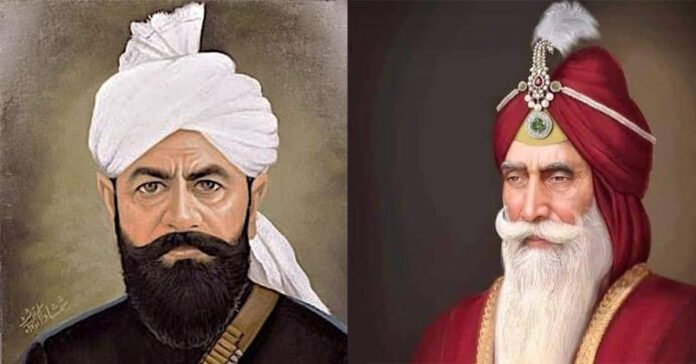Maharaja Ranjit Singh and Rai Ahmad Khan Kharal were contemporaries.
The chief of Kharal (also spelled Kharral) tribe, Rai Ahmad Khan (1776-Sep 21, 1857), led the war of resistance (1857) against the British Raj in areas called Neeli Bar (between the River Sutlej and the River Ravi) and Sandal Bar (between the River Ravi and the River Chenab) of Punjab.
People in Punjab (Western) mark his martyrdom every year on September 21. However, unlike Dulla Bhatti (1547-1599) and Bhagat Singh (1907-1931), Sikhs have largely denied Rai Ahmad Khan equal rank with these two legendary heroes of Sandal Bar.
The reason, perhaps, is obvious: Rai Ahmad Khan had declared the rebellion against the British, proclaiming his loyalty to Delhi Fort of Mughals whom Sikhs regarded as worse enemies than the British due to the long history of Mughal kings’ hostilities against Sikh Gurus. Also, Rai’s martyrdom was a direct consequence of the spying carried out by the feudal lords of the Sandal and Neeli bars. Historians say that among the Muslim landlords belonging to Syed, Langrial, Khakwani, Daha, Kharral, and Arain clans, some leading Sikh and Hindu sardars of the area also deceived the resistant leader, leading to his fall. Those Sikh and Hindu sardars included Khem Singh Bedi, Sampuran Singh Bedi, Dhara Singh Nakai of Gogera, Kanhaiya Ram Arora and Jamaat Singh Khatri of Depalpur.
Sworn Brothers:
However, interesting fact is that Rai Ahmad Khan is believed to have been the sworn brother of Maharaja Ranjit Singh. The Sikh ruler founded the first sovereign Punjab state which fell to British colonial rule in 1849, following the second Sikh-Anglo War and 10 years after his death.
Historian and professor Dr. Saeed Bhutta narrated this fact in his book ‘Nabar Kahani’, quoting Mian Khushi Muhammad Phogi. Another young historian and writer from Jhang, Punjab, Zaki Naqvi, also recounted the story in his vlog.

Cow Slaughtering Story:
During his reign, Maharaja Ranjit Singh imposed a strict ban on cow slaughter, instituting capital punishment for any violation. But the Nissowana tribe (a sub-caste of the Sial clan, mostly residing in Jhang and Chiniot), incurred the wrath of the Maharaja when they slaughtered several cows during a marriage ceremony. They, according to Zaki Naqvi, were arrested and put in jail.
With the death penalty looming over their men, the women of the Nissowana tribe approached Rai Ahmad Khan, as everyone knew of his bond of brotherhood with the Maharaja.
In Punjab, when women from another family or tribe visit someone’s home with a request, it is considered a mark of great honour and respect. So, the chief of Kharral had no other option but to set out for the Maharaja.
Here Zaki Naqvi narrates an interesting exchange of dialogue between Rai Kharral and Maharaja of Punjab.
Exchange of Dialogues:
Ranjit Singh to Rai: Do you know what crime they (Nissowana people) have committed?Rai: Yes
Maharaja: And you know the penalty?
Rai: Yes
Maharaja in anger: Then why have you come to me?
Rai: Women approached me for help.
Maharaja, himself a Punjabi and well aware of the tradition, fell silent for a moment.
And then he asked Kharal: Would you pay a fine if I forgive their capital punishment?
“Yes. My lord!” Kharal replied and at this Maharaja commuted the punishment to a fine of Rs4,000.
It was huge a amount and Maharaja believed Kharal could not arrange it. But, Zaki Naqvi says, Rai Ahmad Khan approached Maharani Jind Kaur, who also regarded him as her brother. He borrowed the money from the queen, paid the fine to the Punjab’s exchequer and brought the Nissowanas back home. The beloved queen of Maharaja never sought repayment from his brother Rai Ahamed Khan till her death on August 1, 1863 at the age of 45.
(Professor Bahauddin Naul from Government College Jhang and Zaki Naqvi made valuable contributions to editing and enhancing this story. By: Iftikhar Alam)



